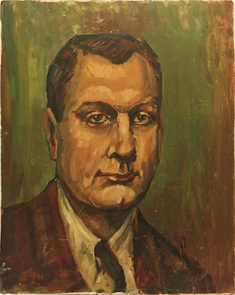Punk Rock Spy, An Idea for a First draft of a Work in Progress - by Manny Mendoza

This may be the favorite out of my whole collection. It's a mid-century oil painting on an artist board. What a mug on this guy!
His story is channeled by Manny Mendoza, journalist and dance/art/culture critic. I had always thought the gentleman in the painting was a CIA agent named Roger. Manny riffed on that idea, inspired by his own years as a music critic and punk rock fan.
Manny's story begins in his own voice, then shifts to that of the subject.
"Here’s the true part: A friend and I went to a punk show at the Ritz Theater in New York in the spring of 1987. It was a Thursday night, and a band called Husker Du, whose manager had just committed suicide, played their latest album, a double, start to finish, as if it were their last performance. The furious set ended with four encores that included their signature covers, The Byrds’ “Eight Miles High” and “Love is All Around” the theme from the Mary Tyler Moore Show. Husker Du was from Minneapolis like Mary.
I’ll never forget the band’s guitarist, Bob Mould, leaning into his amplifier, his face twisted into a pained grimace as he elicited squalls of feedback the likes of which I’d never heard before. Sharing the room with us among the pierced and pogo-ing was a middle-aged man in a suit. What was he doing here, my friend Neil wondered. He did not look like a guy who would be at this show. Neil thought he bore a striking resemblance to G. Gordon Liddy. I pegged him as some kind of spy, maybe a CIA agent investigating this noisy rebellion.
When I first saw Roger's portrait, I immediately thought of the out of place gentleman at what has become my favorite concert of all time.
This is how he would tell his story:
"I retired five years ago. It leaves me more time to go to punk rock shows and to think about why the music means so much to me, why it has meant so much to me since it came along and wiped out all that hippie bullshit.
Don’t get me wrong. When I first joined the agency in the late ’60s, I was listening to Hendrix and the Who and a little later Led Zeppelin. The raw power of that sound, the violence in it – not that I thought about it this way at the time – correlated to what I was learning as a U.S. intelligence officer about the human capacity for rage.
By the early ’70s, though, it was over for me. So-called progressive rock bands like Yes and Emerson, Lake and Palmer had ruined music as far as I was concerned. I remember buying “Brain Salad Surgery” in 1973 and listening in disbelief to the soporific shit that rock had become. What did pretentious lyrics and third-rate classical music have to do with me and the dangerous world I was becoming increasingly aware of? I wanted music that reflected that world.
Then punk happened. It was like a razor cutting through a bloated carcass. By the time hardcore punk became the prevailing style in the early ’80s, I was convinced the ayatollah, the strongmen who ran Latin America, my bosses, all the violent bad asses I was dealing with at the office, so to speak, would recognize themselves in that sound.
This wasn’t music for snotty kids or hipsters who reflexively hated the organization I worked for, or not just for them. In fact, I often listened to X’s second album Wild Gift or Black Flag’s Damaged as a way of preparing myself for some of the less savory aspects of my job. I mean, what better mantra to carry in your head as you try to pull a confession than, “We’re desperate, get used to it?”
Last week, I went to the Ritz to see Husker Du. They’re from my hometown of Minneapolis, so I was familiar with their music. I’ve liked them since I caught a show at 7th Street Entry after their third album, New Day Rising, raised the band’s profile, and they signed to a major label. They’ve put out three more records since then, the latest a double album packed with 20 songs. At the Ritz, they played the entire record in chronological order. It was monumental.
As usual, I was dressed in a suit. It drew stares from those who like to turn their cultural preferences into a fashion statement and wonder why everyone else isn’t doing the same. I was used to this reaction, conformity dressed up as its opposite, and I could sympathize. The suit was my uniform at work, a way of blending in. At punk rock shows, it made me the biggest nonconformist in the room. Me and those kids, ironically if not paradoxically, have a lot more in common than they realize."